 Thanks: 0
Thanks: 0
 Likes: 0
Likes: 0
 Needs Pictures: 0
Needs Pictures: 0
 Picture(s) thanks: 0
Picture(s) thanks: 0
Results 1 to 15 of 15
-
6th Apr 2012, 04:42 AM #1
 Damascus, Swords, Drop Hammer etc
Damascus, Swords, Drop Hammer etc
Hi,
Here is a bit of a idea of the somewhat crazy things i've done....
I can probably put my hands on my first ever knife and first ever damascus, but not tonight. Here are some things i can get my hands on easily (call it home security )
)
This is one of my earlier knives. It once was a file, with a forged blade, ground fuller and forged guard. As you may notice subtlety was not in my repertoire 10+ years ago.
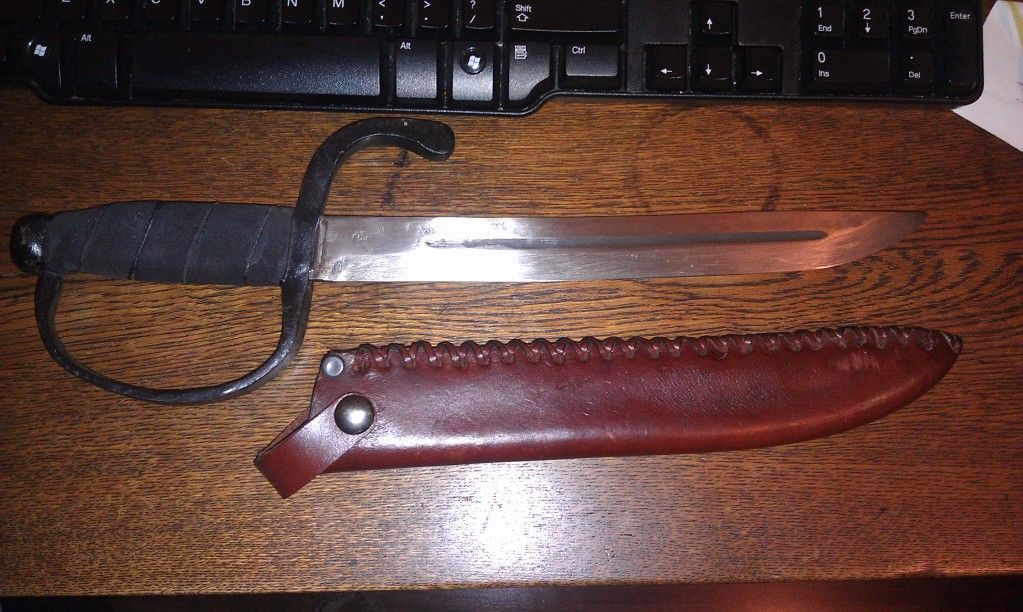
Here are three damacus efforts, all done by hand before the drop hammer. There would be at least 10 hours of work just in the billet for the top two (yes i had a strong right arm....once!)
(yes i had a strong right arm....once!)
The top one is used in the kitchen daily, and was really a pattern test, as you may notice, each side is different, one is a twist and the other is random. Maybe 6-7 years old.
The second is later than the first but i ended up with a few inclusions and it got a bit thin with me trying to seal them up. Good clean twist pattern though.
The last is my first and only try at cable welding. O.K it sux...in my defense some idiot (me) only had gal cable and the zinc stopped most of the welds....


All three would have been etched with ferric-chloride, and you can easily see that the cable blade is only made from one type of steel as there is no dark patches. My first damascus is the same but only because it took me so long and i probably got it too hot and ended up with massive carbon migration. I'll see if i can find it.....
Ewan
-
6th Apr 2012, 04:53 AM #2
 Swords
Swords
Here are some sword pics. Most of the ones i have are "real" photo's and i don't have a scanner...and the album is still in a box somewhere (hey we have only been in this house 3 years, can't rush these things)
Forging a falchion guard

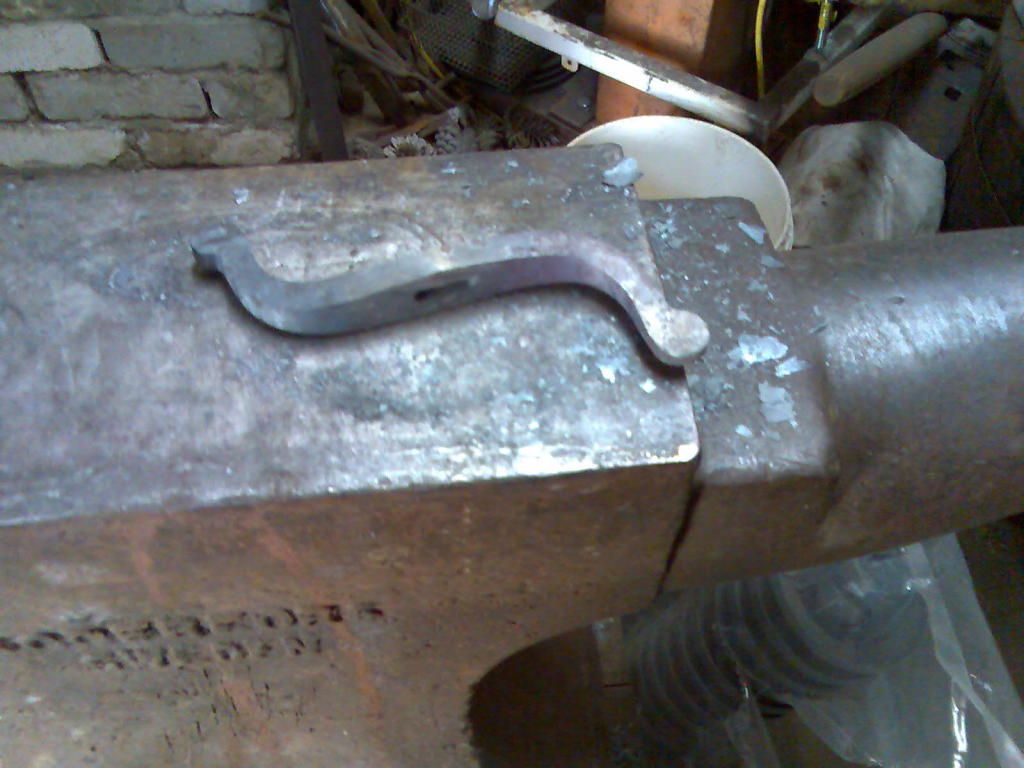
Milling a narrow fuller in a blank
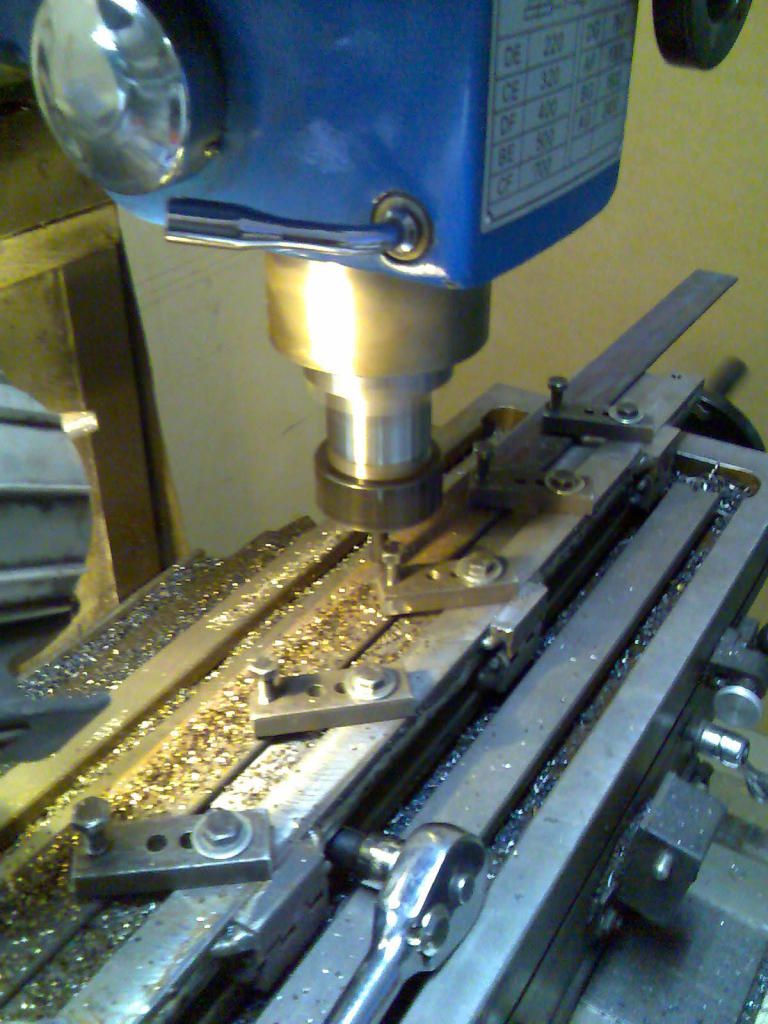
I would reckon the prettiest (and longest @ about 1.25m) sword i've made
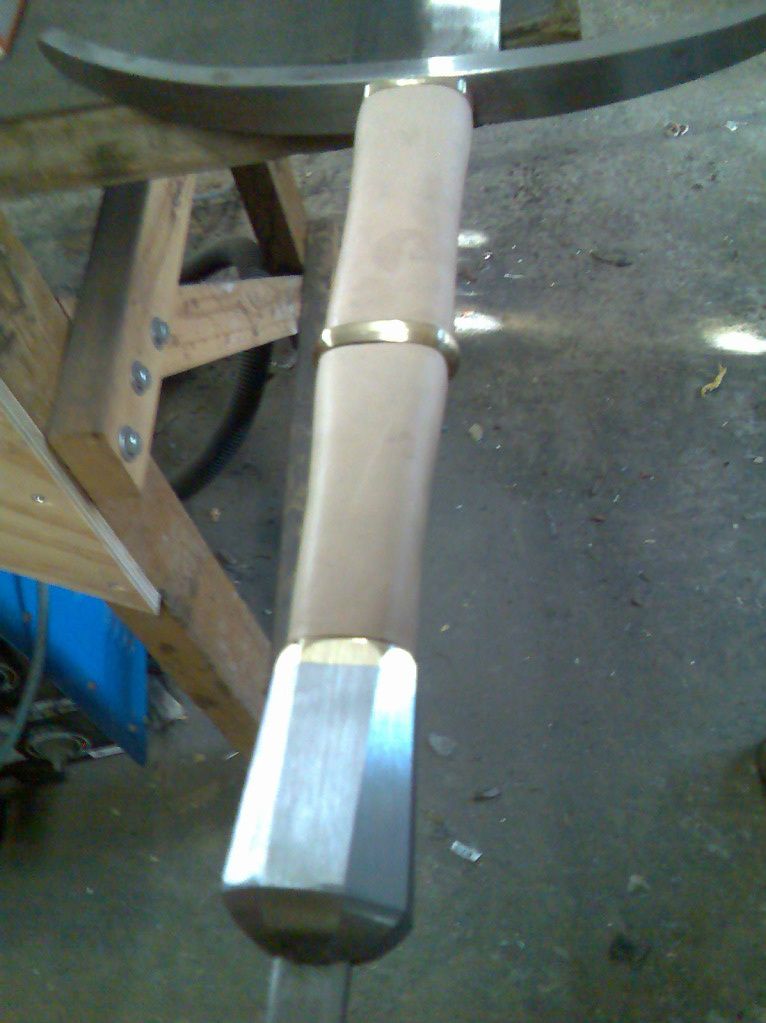
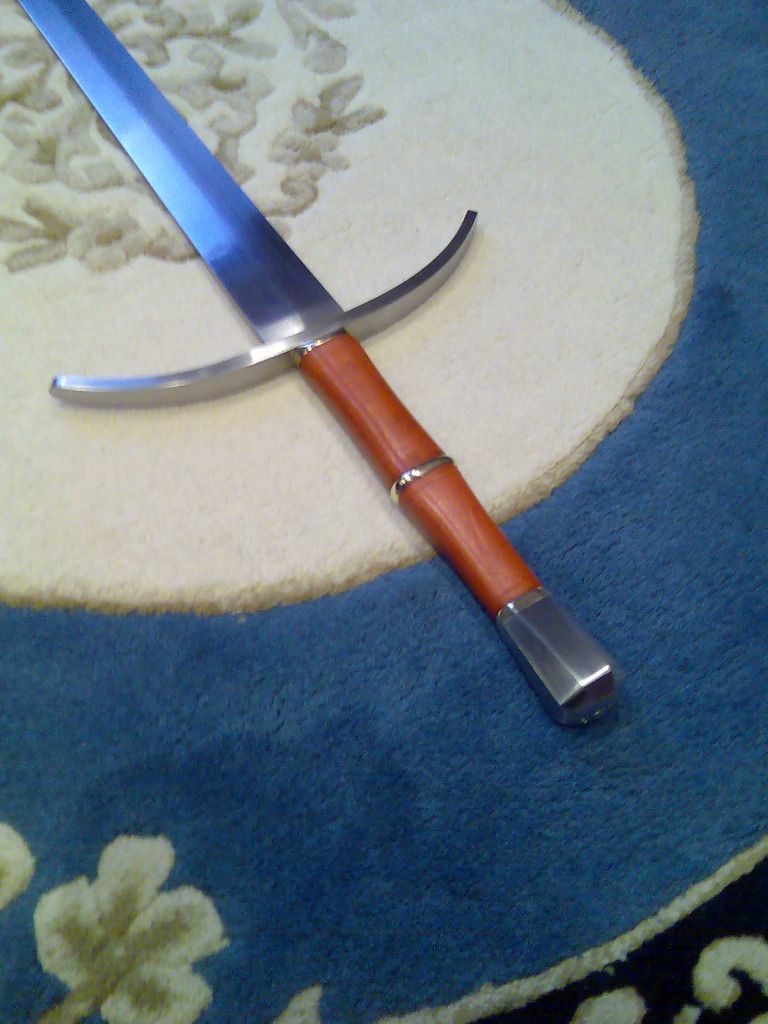
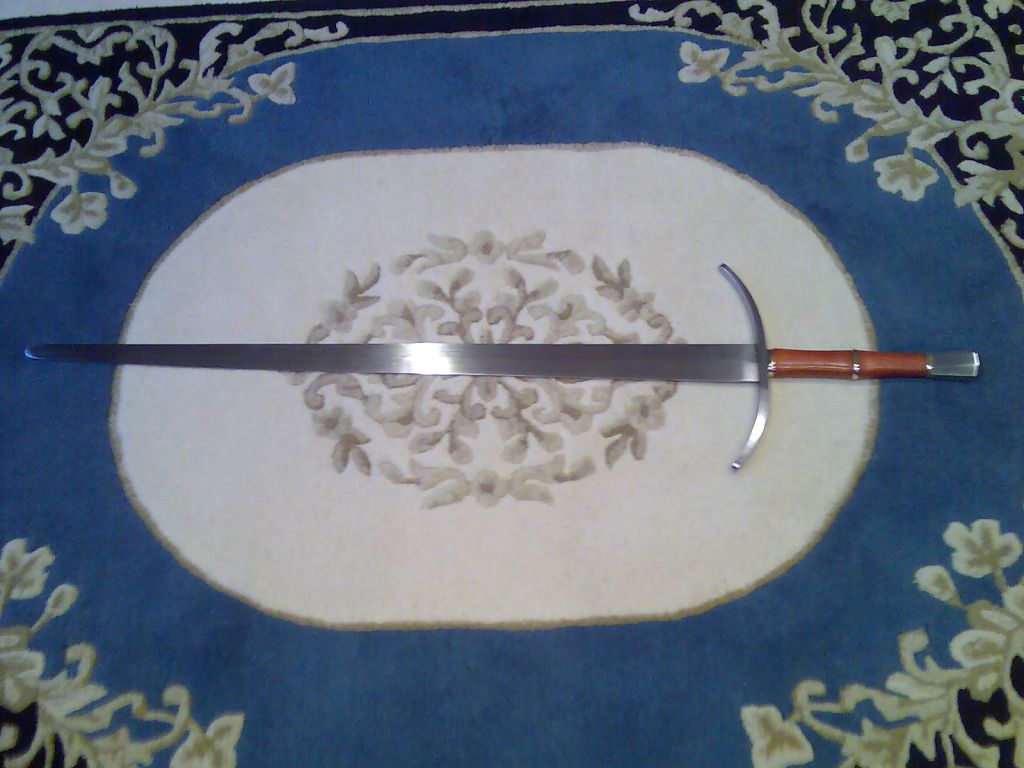
Cast fittings (or furniture as it is known) on a blade
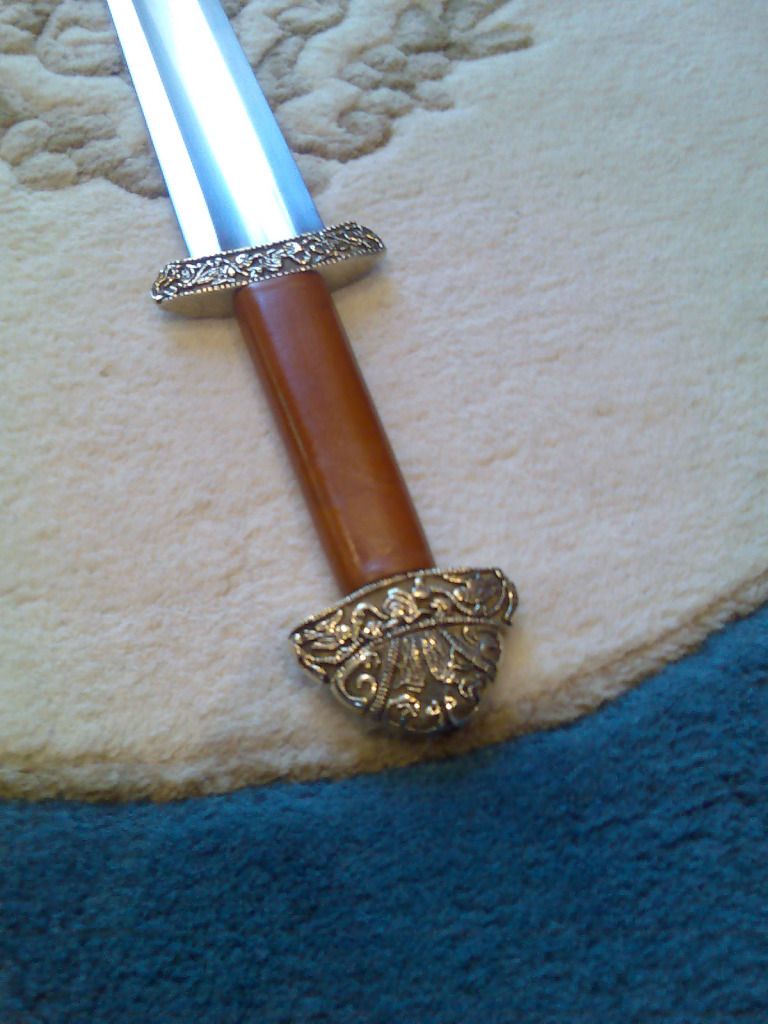
Ewan
-
6th Apr 2012, 05:01 AM #3

Some "in the rough" pics. Don't seem to have a digital of this one finished.
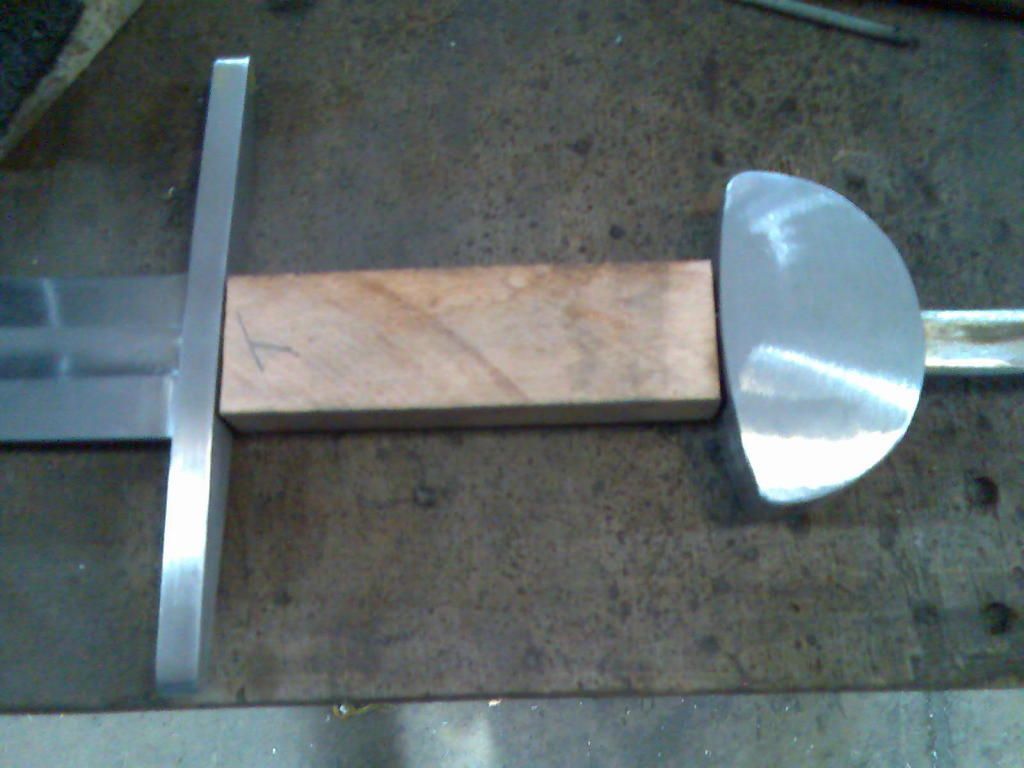
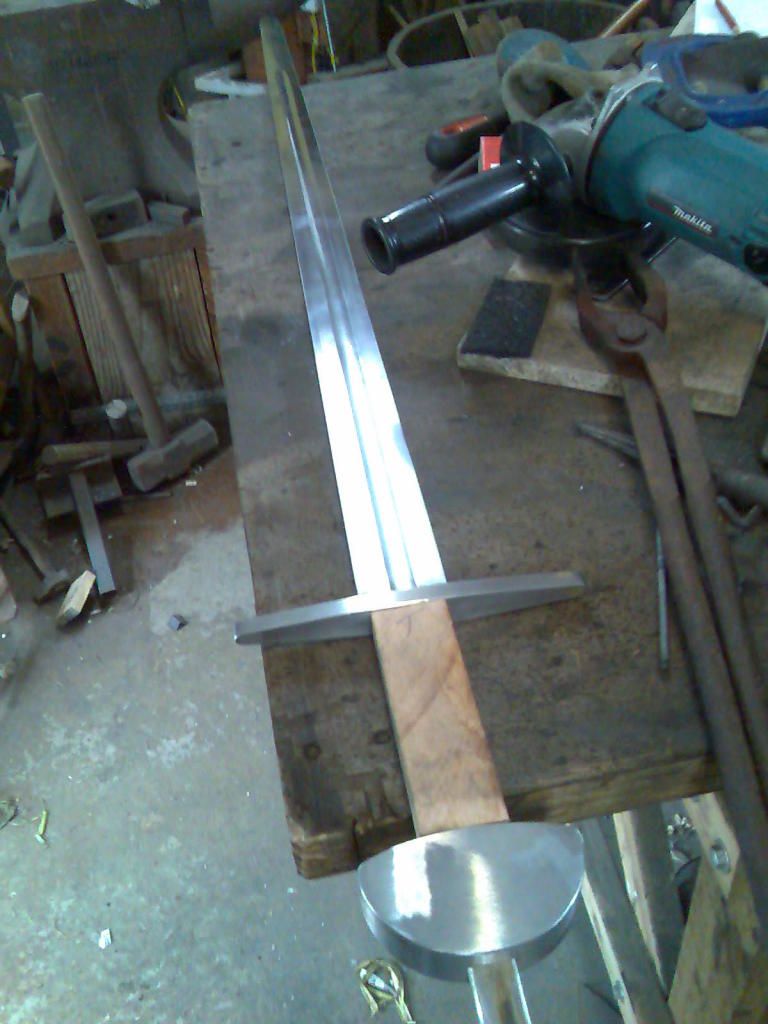
Probably the biggest challenge to date...fun though
Theres a guard in there. (thats 35mm thick plate)
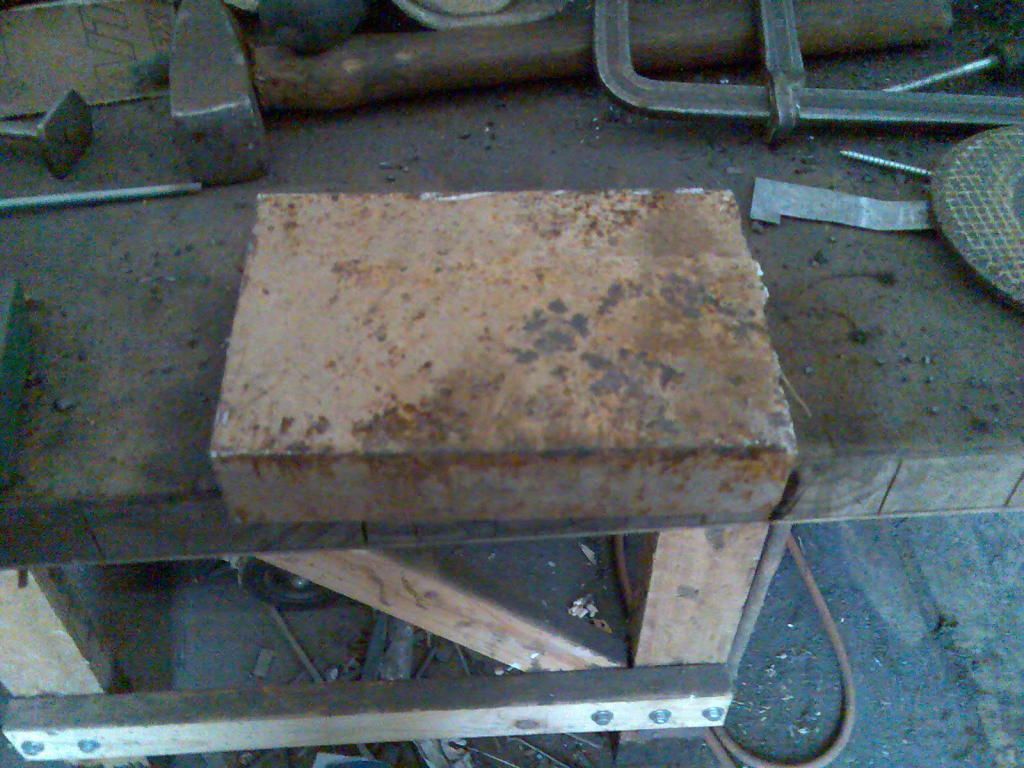
Now thats alot of waste gone!
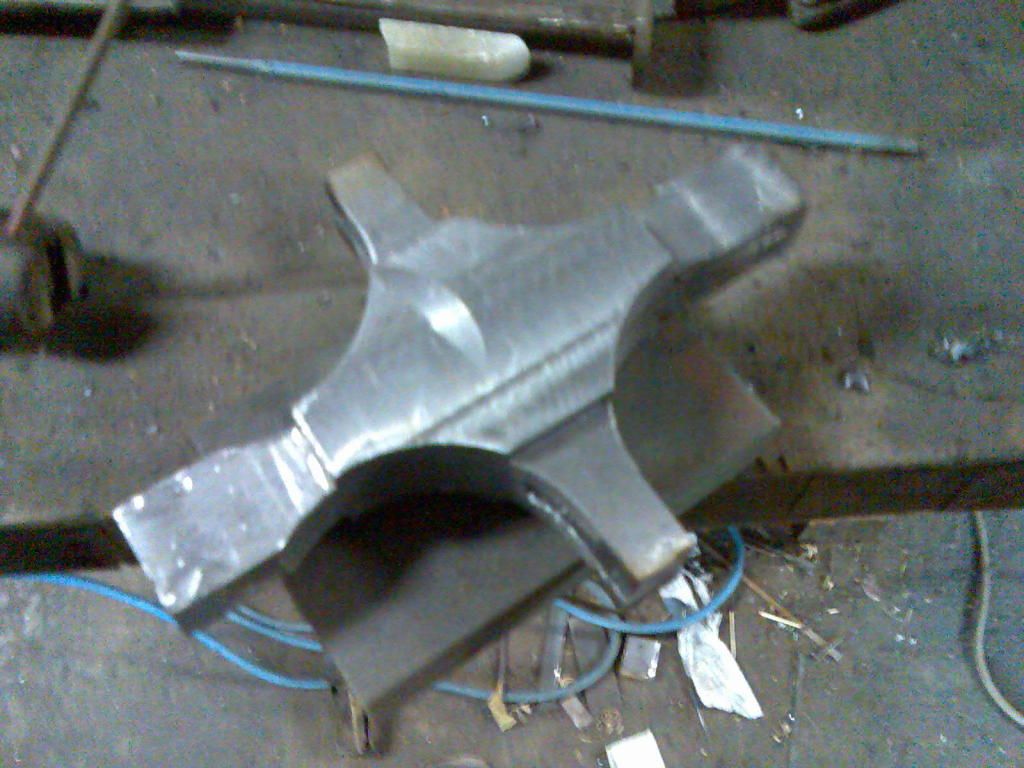
Finished product...
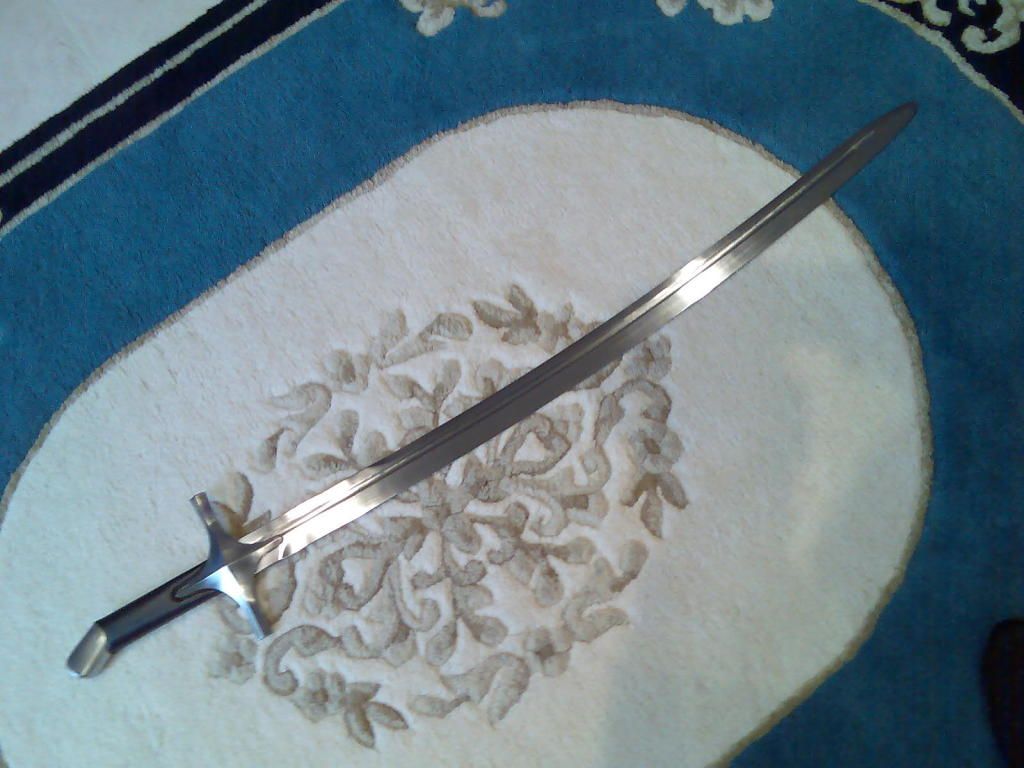

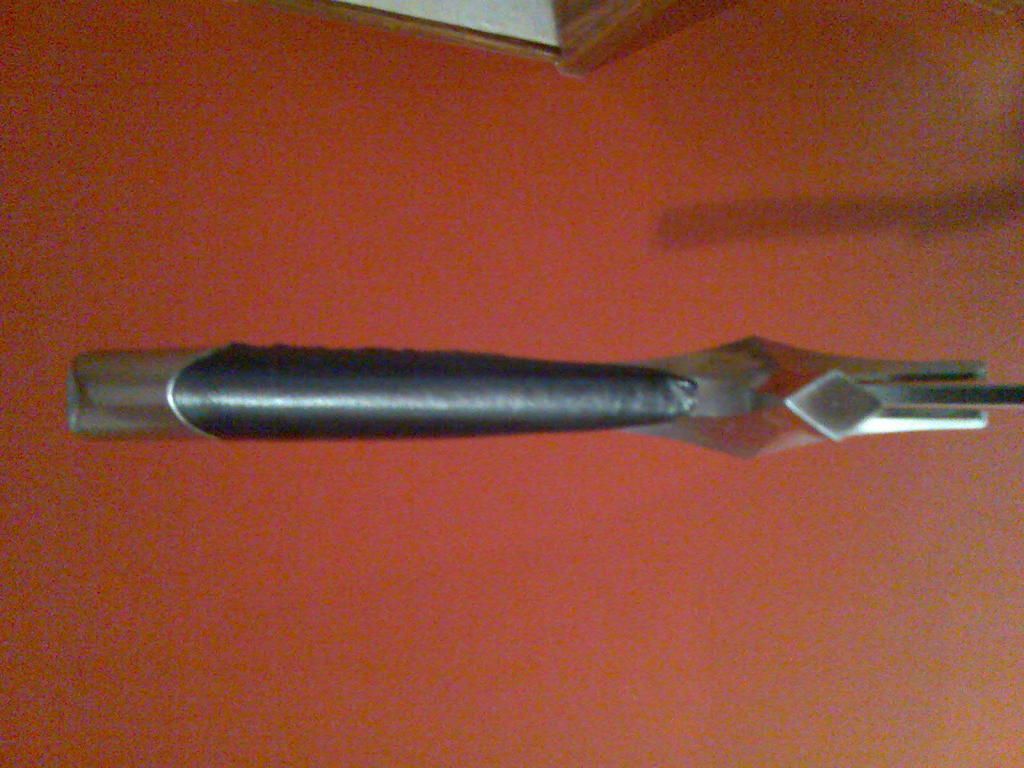
Well its 4am and i'm sure i can squeeze in 2 or 3 hours shut-eye before Arthur wakes up full of energy and ready to go!
EwanLast edited by Ueee; 6th Apr 2012 at 05:02 AM. Reason: Spelling and 4am doesnt mix
-
6th Apr 2012, 05:18 AM #4

Very pretty toys! Good to see such work.
 Pat
Pat
Work is a necessary evil to be avoided. Mark Twain
-
6th Apr 2012, 09:07 AM #5

Impressive! My biggest question though: how well do the knives perform as knives? Do they hold an edge well and resist snapping?
Tom.
-
6th Apr 2012, 09:33 AM #6

Ueee,
Congratulations on some fine looking work.
Having made a number of knives by stock removal I can really appreciate the work that has gone into your forged knives and swords.
The just something about the look and fit of steel, brass and timber that is very self satisfying.
Is there any chance you can write about the forging process as I want to build one in the not too distant future.
It also good to see that like me you don't put excessive amounts of time into the shop floor,though you still have some way to go as unlike mine you can still see a fair amount of concrete floor


Cheers
Grahame
-
6th Apr 2012, 09:57 AM #7
 Diamond Member
Diamond Member











- Join Date
- Oct 2011
- Location
- Sydney, NSW
- Posts
- 1,249

Ueee,
Nice work. I don't know much about making knives or swords so I agree with GC, post some info on how you done it.
Ben.
-
6th Apr 2012, 10:54 AM #8
 .
.











- Join Date
- Nov 2008
- Location
- Perth WA
- Age
- 71
- Posts
- 6,459

Ewan,
I was looking at the fullers on your swords and wondering about their creation in the days before vertical mills and ball end cutters. All came down to the skill of the swordmith and his ability with a grinding wheel I guess.
I was under the common misapprehension that the fuller was to facilitate hemorrhaging and to aid in the removal of the blade from someone's gizzards, but a quick bit of investigation revealed that the groove served to lighten the blade.
The Blood Groove « The BS Historian
The damascus patterning is fantastic.
Have you had a crack at damascening yet? The photo below is of a breastplate on display at the Musee de L'Armee in Paris. If you haven't been there and do intend going to Paris, you'd need to allocate at least a day to the Musee...
BT
-
6th Apr 2012, 11:09 AM #9
 Distracted Member
Distracted Member











- Join Date
- May 2010
- Location
- Lower Lakes SA
- Age
- 58
- Posts
- 2,607
-
6th Apr 2012, 03:19 PM #10

Hi Ewan,
Beautiful work, very impressed.
We are waiting on the current batch of M2 chisels and plane blades to come back from Hills, looks like they did a great job on your swords. Any problems with distortion?
How much shaping is done before heat treatment, versus grinding afterwards?
Regards
Ray
-
6th Apr 2012, 11:46 PM #11

Thanks Tom.
Damascus is a little different to plain iron or steel, it takes on some unique qualities when made in a correct number of layers. To many layers and you end up with medium carbon steel, too few and the serations too big and the blade looses flexibility. Firstly, the iron allows flexibility, even if the steel cracks the iron doesn't. The steel is hardened and therefore holds an edge, but the iron on the edge quickly wears away leaving hundreds of tiny serrations that cut sinuous materials very well, but are not so useful in tools. The pattern also has a lot to do with the serations, which is where the traditional twist pattern shines
Ewan
-
7th Apr 2012, 12:39 AM #12

Thanks for all the encouragement, I'll try to answer all the questions when I get time.
Ewan
-
8th Apr 2012, 11:44 PM #13
-
9th Apr 2012, 12:29 AM #14

Hi,
I thought i'd throw in a bit of history, as i understand it anyway.
Pattern welding has been around for a long time, the Japanese are probably most noted for it, mainly as there history and artifacts are so well preserved. Many good examples of early AD viking and celtic weapons also appear to be pattern welded, but i wonder just when it was discovered? One would presume that enough iron to make a sword back then would have to come from more than one source, and its carbon content would vary alot. The smith would have to forge weld all the bits together to make the sword, until one day some smart guy works out that swords with many smaller pieces welded together in layers was stronger and developed a pattern.
Forge welding is unlike modern welding in that a good weld completely joins the pieces together as if they were never separated. It is done by cleaning the surfaces, scarfing them, fluxing with either fine sand, or these days borax, heating till the surface of the iron becomes molten and then forcing the pieces together. The first hammer blow makes almost a popping sound as all the molten flux is ejected out of the join, at great speed, in a 360 deg shower of sparks. Once the join has stuck, the piece can be returned to the fire, re-fluxed and finished. Of course, allowances have to be made as the join will change shape as it is welded.
Some terminology:
Flatter: would appear like a hammer to most, but with a very broad (3-4" sq), slightly convex face and is sat on the work and struck with a hammer to smooth the beaten surface.
Top Fuller: again like the flatter but with a set radius face, for forging rounded shoulders, or, you guessed it, fullers in blades
Bottom Fuller: made to match the top fuller but would go in the hardie hole of the anvil.
To make a sword, the smith would first draw out that tang, which should be tapered in both planes, and finish it with his flatter until smooth.
The fuller would then be forged, with a set of matching fullering tools, one in the hardie hole of the anvil and one held by the smith. Great care would have to be made to make sure the tools lined up. All smiths would have had strikers or apprentices that would do the hitting, usually in pairs- one right handed and one left. Clearly the more blows that could be landed in one heat the faster the item could be made. Once fullered the bevels would be forged on either edge, bit by bit, doing both sides at the same time to make sure the blade stayed straight( for double edged swords) or for single edged swords the blade had to be bent towards the edge first to compensate for the beveling increasing the length of one side of the blade only. Once finishes the flatter would once again be used to smooth the surface.
The blade would then be annealed by heating it and either leaving it in a dying fire or burying it in lime. The blade would them be hardened by heating it to its curie point (the point at which steel looses its magnetism) and quenched in brine (brine cools more slowly than water) and then tempered. Hardening and tempering where often done after initial filing, and the blade would be carefully coated in a special, secret mix of clay, charcoal, wood shavings, iron filings etc etc to inhibit and loss of carbon and any oxidization caused by the oxygen rich environment in the fire (of course building a good fire that burns up most of the oxygen supplied to it before it damages the steel is another thing entirely)
In early times the smith would have finished the sword personally, but in later times all the parts would go onto a cutler for assembly, polishing and sharpening.
As Bob pointed out, fullers have nothing to do with the reduction of hydrolic shock, but rather to lighten and strengthen the sword, and later for decorative purposes. Think of is as an I beam....The older wide fullered viking blades were not actually fullered wit ha radius but were actually flat bottomed with a radius leading up to the ridge of the blade.
Another couple of things to think about is swords where relatively rare- only the rich and high class members of society owned them, most of the general soldiers used spears, axes and other staved weapons. Also, the average sword is probably a lot lighter then you may think. For a 6' man a blade length of around 30-32" would be right (if you hold a sword in you strong hand, sort of tucked under your arm, elbow pointing skywards, hold out you other arm with your thumb up, the tip should just touch you fingernail) and would weigh about 4lbs, with its balance 4 finger widths in front of the guard.
I hope that quenches at least some thirst for knowledge, although its probably more like a taster....
Ewan
-
9th Apr 2012, 06:47 AM #15
Similar Threads
-
Damascus/ironwood knife
By ohno in forum KNIFE MAKINGReplies: 25Last Post: 18th Nov 2006, 11:17 AM




 Reply With Quote
Reply With Quote

